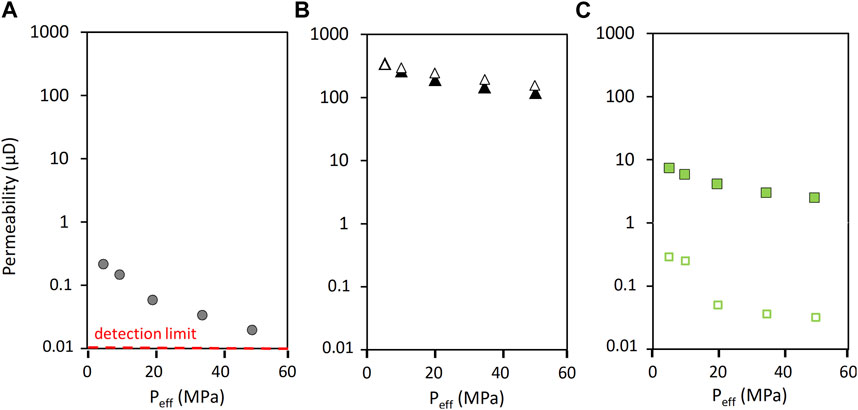Corrigendum: Using acoustic velocities and microimaging to probe microstructural changes caused by thermal shocking of tight rocks
- Rock and Geomaterials Laboratory, Stanford University, Stanford, CA, United States
A Corrigendum on
Using acoustic velocities and microimaging to probe microstructural changes caused by thermal shocking of tight rocks
by Malenda M and Vanorio T (2023). Front. Earth Sci. 10:1054469. doi: 10.3389/feart.2022.1054469
In the published article, there was an error in Figure 9 as published. Two of the datasets were mistakenly calculated using the incorrect unit conversion. The correct Figure 9 and its caption appear below.

FIGURE 9. Permeability versus Peff for the SWG (A), PTB (B), and MSA (C) lithologies before and after thermal shocking. Smaller, empty symbols represent k data associated with pre-thermal shocking and larger, filled symbols represent k data associated with post-thermal shocking. Permeability for the SWG sample before thermal shocking was below the detection limit of the permeameter (0.01 μD), and therefore is not plotted. Error bars are less than 1% of measured values.
The following text corrections were also made to reflect the corrected data.
A correction has been made to Results, Time-Lapse Rock Physics Measurements of Thermally Shocked Lithologies, Paragraph 2. This sentence previously stated:
“The post-thermal shocking SWG k is presented however, and we see that k significantly increased by several orders of magnitude.”
The corrected sentence appears below:
“The post-thermal shocking SWG k is presented however, and we see that k increased by at least an order of magnitude.”
A correction has been made to Results, Time-Lapse Rock Physics Measurements of Thermally Shocked Lithologies, Paragraph 4. This sentence previously stated:
“Figure 9C shows that MSA permeability increased significantly upon thermal shocking, regardless of effective pressure. Additionally, the spread in k increased from less than 1 μD to almost 5,000 μD with thermal shocking, meaning that similar to PTB, the pressure sensitivity of k increased with thermal shocking.”
The corrected sentence appears below:
“Figure 9C shows that MSA permeability increased upon thermal shocking, regardless of effective pressure. Additionally, the spread in k increased from less than 1 μD to almost 9 μD with thermal shocking, meaning that similar to PTB, the pressure sensitivity of k increased with thermal shocking.”
A correction has been made to Discussion, Paragraph 10. This sentence previously stated:
“Thermal shocking was so effective in MSA, that the permeability of the MSA sample increased substantially (Figure 9). Not only did thermal cracks propagate throughout the MSA sample, but they connected to one another allowing for permeability to increase by almost 10 Darcy.”
The corrected sentence appears below:
“Thermal shocking was so effective in MSA, that the permeability of the MSA sample increased (Figure 9). Not only did thermal cracks propagate throughout the MSA sample, but they connected to one another allowing for permeability to increase by almost 10 μD.”
The authors apologize for these errors and state that this does not change the scientific conclusions of the article in any way. The original article has been updated.
Publisher’s note
All claims expressed in this article are solely those of the authors and do not necessarily represent those of their affiliated organizations, or those of the publisher, the editors and the reviewers. Any product that may be evaluated in this article, or claim that may be made by its manufacturer, is not guaranteed or endorsed by the publisher.
Keywords: thermal shocking, microstructure, elastic moduli, permeability, time-lapse, micro-imaging, tight rocks
Citation: Malenda M and Vanorio T (2023) Corrigendum: Using acoustic velocities and microimaging to probe microstructural changes caused by thermal shocking of tight rocks. Front. Earth Sci. 11:1179277. doi: 10.3389/feart.2023.1179277
Received: 03 March 2023; Accepted: 20 March 2023;
Published: 03 April 2023.
Edited and reviewed by:
Paolo Capuano, University of Salerno, ItalyCopyright © 2023 Malenda and Vanorio. This is an open-access article distributed under the terms of the Creative Commons Attribution License (CC BY). The use, distribution or reproduction in other forums is permitted, provided the original author(s) and the copyright owner(s) are credited and that the original publication in this journal is cited, in accordance with accepted academic practice. No use, distribution or reproduction is permitted which does not comply with these terms.
*Correspondence: Margariete Malenda, malenda@stanford.edu
 Margariete Malenda
Margariete Malenda Tiziana Vanorio
Tiziana Vanorio